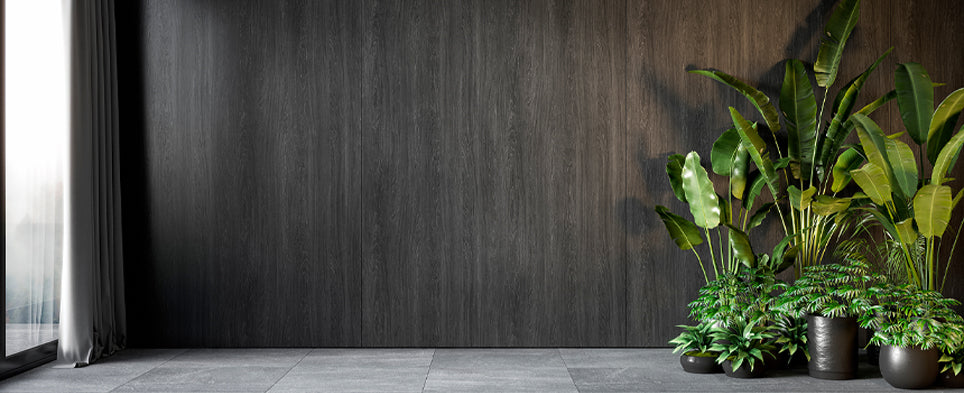
Plants come in all shapes and sizes and not all of them grow the same. Contrary to popular belief, some like the dark! Most don’t grow in complete darkness, though.
They still need low-light conditions, but a shady spot or dark office could still be a suitable space for some plants. Most common indoor houseplants are tropical plants because they thrive in indirect light and their broad leaves can absorb as much sunlight as possible.
If you’re a plant parent first timer or an absolute beginner, you’re in luck. Less sunlight most likely means less maintenance which means a better chance for your plant to live longer despite the inexperience. Hooray. If getting into plants seems like a daunting task or you’ve had no luck so far, this list might help you find the right plant that likes the dark.
Snake Plant
Dracaena trifasciata, which used to be botanically referred to as Sansevieria, and commonly known as the “Snake Plant”, are very popular houseplants because of their low maintenance. They have stiff, erect leaves that look like swords and are typically green with yellow borders, although they grow in a variety of colors.
They are very resilient and adaptable making them a top houseplant contender. A fun fact about Sansevieria Snake Plants is that during NASA’s 1989 clean air study, they discovered Snake Plants purify the air!
Care
They’re easy to care for, requiring minimal watering, only needing water if the soil feels dry. They are succulents so they retain water in their leaves. Overwatering could rot the roots so water sparingly. Snake Plants thrive in warmer weather and during the hottest months should be watered around every two weeks. They can tolerate high light adding to their versatility.
Tips
- Increasing exposure to light will boost growth
- Planting and repotting is best done in spring
- Struggle with temperatures below 50 degrees Fahrenheit
WARNING: toxic to dogs and cats!
Hanging Spider Plants
Spider plants are yet another low maintenance addition to the list. The hard-to-kill houseplant also thrives in low light areas helping give life to living rooms and bedrooms. They have long, narrow leaves and grow aggressively outwards in every direction, although slowly.
Like Snake Plants, this plant also helps remove harmful toxins from the air making any room livelier and healthier. They are great as hanging plants due to their cascading growth. If you want one of your own, there are plenty of spider plants for sale now at www.soilandclay.com.
Care
They’re also easy to care for, preferring their soil to dry out between waterings. When watering, distilled water and lightly moistened soil is best. For optimal growth outdoors, light shade is ideal. For indirect sun, near a bright window is best. Spider plants are also easy to propagate. All you have to do is pot up the small plantlets hence the nickname “airplane plant”. They can grow small white star shaped flowers. Practically indestructible, this is a go-to for beginners.
Tips
- Should be fertilized from spring to fall
- Grow stunningly with warm temperature and humid air
- Repot if roots outgrow the container
- Excessive direct light outdoors can scorch the leaves
- Remove dead or browning leaves
Pothos N Joy
Pothos plants are common houseplants in the US. They have green heart-shaped leaves with cream/whitish spots and are perfect for shelves. Also known as Devil’s Ivy, they can absorb harmful toxins, too. They can grow from 20-40 feet when mature. Their trailing vines make them great as eloquent hanging baskets.
Care
If you’re forgetful, always busy, or never home, fear not, this plant needs little watering and can easily grow well in a dark corner. You can water them when the top soil is dry. Pothos can grow into long vines so it’s best to support them with hooks or window frames. They prefer bright but indirect light. Pothos are tolerant of soil pH but thrive in well-draining potting soil.
Tips
- Shake them loose to prevent tangling
- They do not cling to supports on their own
- Moving them to brighter spots can restore their variegation
- Grows best in temperatures ranging from 60-80 degrees fahrenheit
- Drooping means the roots have filled the pot
WARNING: toxic to pets.
FAQs
Can houseplants survive outside?
Yes. Houseplants that like warm weather and direct sunlight do well outside. Make sure to read up on their specific ideal light and temperature conditions because plants which prefer indirect light might burn outside.
It’s best to help plants acclimate by placing them in shadier spots in gradually exposing them to more light. Night temperatures below 55 degrees are not suitable for most houseplants and during the winter acclimate them back inside.
Can houseplants survive with no light at all?
No. Even the most shade-tolerant plants will need some form of indirect light from a window or even artificial light for a few hours. Low-light plants thrive in shady conditions with indirect light, not in completely dark spaces. But, Bromeliads can tolerate almost zero sunlight.
When should I water?
Most plants have slightly different watering schedules but for low light plants it’s better to water as needed to avoid overwatering. Make sure to use soil with good drainage with an appropriate container that can properly fit the roots. A good rule of thumbs is succulents need less water and flowering plants typically need more.

